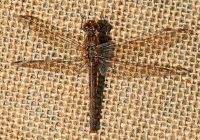Dr Phil Smith’s Wildlife Notes
October 2021
October had a total of 16 rain-days, being wet and windy early and late in the month, with a dry 10-day period in the middle. It was exceptionally mild throughout, daytime temperatures reaching 210C on 8th. Gales in early October blew in masses of sand, deeply burying the rich strandline vegetation at Ainsdale that I highlighted in the September notes. The associated 10m high-tides washed up drifts of seaweed, presumably from North Wales, which will provide the nutrients for next summer’s strandline plants.
As in October last year, the relatively warm weather kept insects going longer than usual. I did particularly well at the Ravenmeols Ivy on 10th, where 13 different kinds of hoverfly were battling for nectar with masses of Common Wasps. Most of the flies were common species but I was pleased to see the humbug-like Broad-banded Epistrophe and two superb female Hornet Hoverflies, one of which was so tame I got it to perch on my finger. Butterflies were represented by 10 Red Admirals, two Commas and a late Speckled Wood. Bits and pieces included a Noon Fly, a Hairy Shieldbug and a brief visit by an Ivy Bee, which was immediately attacked by a wasp. There were still 10 Common Darters basking on bare patches and sunny logs. I continued to find these darters until the last perched on my bag on 24th. Other nice finds included an enormous hairy Fox Moth caterpillar on the Green Beach at Ainsdale. These hibernate as full-grown caterpillars and were quite common up to few years ago but I rarely see them now. A late Northern Dune Tiger Beetle was at the Devil’s Hole on 6th, accompanied by several Field Grasshoppers. On 15th I spotted another Ivy Bee at the top of Range Lane in the same place as one last year. However, this solitary bee that recently arrived from the south is much commoner at Crosby Coastal Park, where I saw at least 10 on 8th, together with several hoverflies, including the Furry Dronefly, an effective bumblebee mimic.
As in October 2020 I found insects on, the sheltered Wick’s Path during sunny weather. The Twin-spot Centurion, an autumnal soldier fly, was present on two occasions, this being the only place I have recorded it. A small patch of flowering Ivy also supported the small but attractive Banded Meliscaeva hoverfly, while a sunny area of bramble to the west of Wick’s Lake had two of the uncommon Pale-knobbed Didea.
Botanical recording wound down during the month, finishing with visits to the most recent Green Beach features north of Ainsdale-on-Sea. These young habitats are amongst our richest for plantlife, including many species that can’t compete with more heavily vegetated, older areas of duneland. As late as 23rd, Yellow-wort was still in full flower, while a few surviving blooms of Grass-of-Parnassus were a reminder of the earlier abundance of this Sefton Coast speciality. I also found a new patch of Variegated Horsetail, an increasingly rare plant in England. Walking back, I nearly trod on a Devil’s Coach Horse, a spectacularly large member of the Rove Beetle family. Mindful of its reputation for a fearsome bite, I didn’t pick it up and was therefore unable to get it onto a plain background for photographs.
On 9th, I visited Ainsdale Sandhills Local Nature Reserve with Joshua Styles. He particularly wanted to see the ‘nationally scarce’ liverwort, Cavernous Crystalwort, which has appeared in great quantity in one of the slacks cleared of scrub by Green Sefton last winter. Several other scarce pioneer plants have colonised the open ground created by this important work to restore functioning dune wetlands. It is perhaps worth reflecting on the fact that such wetlands are known to store up to six times as much carbon as woodland.
Having been unable to work during the Covid restrictions last winter, my volunteer ‘Buckthorn Bashers’ began operations again to clear scrub on the dunes north of Shore Road, Ainsdale. Three events during the month, with up to 11 participants, made good progress cutting mainly Sea Buckthorn regrowth. We were entertained by the brief song of a Cetti’s Warbler as we walked along the board-walk at Sands Lake. I also completed a separate small project to remove Sea Buckthorn from a Natterjack Toad scrape at Hightown. Natterjacks require scrub-free habitats both for breeding and foraging for food.
On 22nd, I joined an ecological consultant, local naturalists and representatives of Green Sefton and Merseyside Environmental Advisory Service to discuss ideas for managing Crosby Coastal Park. These include scrub removal and possible changes to the mowing regime to benefit its rich flora. Dune Wormwood is the park’s flagship species, found at only one other British locality. It is doing well but, being confined to a small area, it is vulnerable to fires. Ideally, we thought it should be translocated to other suitable habitat along the dune coast.






